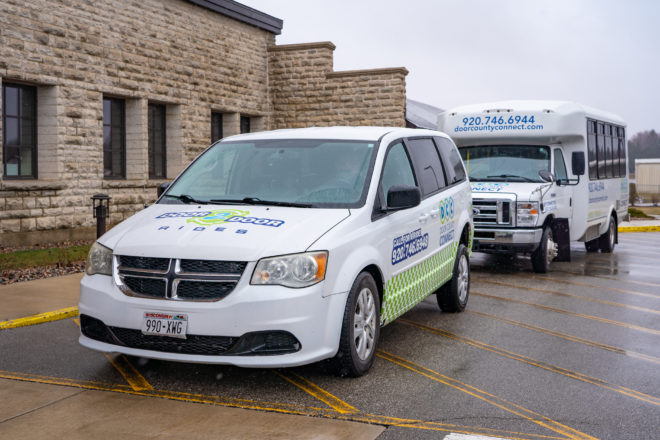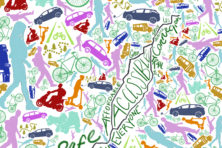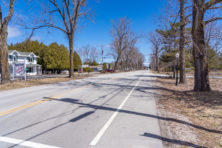Sustainability Issue 2022: Getting People Where They Need and Want to Go
- Share
- Tweet
- Pin
- Share

America has a car-driving culture. In no place is this more evident than in a rural area that’s also widely known and visited as a “drive-to” destination.
Transportation is an essential service, but not everyone drives. In places such as Door County with a land mass of approximately 70 miles top to bottom, the challenges for the nondriving public are heightened by greater distances and fewer public-transportation options.
“And we’re a peninsula,” said Nikki Voight, executive director of Door-Tran, a nonprofit provider of transportation services for Door County residents through multiple programs. “We don’t have resources we can pull from the surrounding communities.”
Aging adults, students, low-income individuals and those with physical, mental or intellectual/developmental disabilities are all part of this nondriving category. There are also those who simply prefer not to drive.
The Wisconsin Department of Transportation (WisDOT) estimates that 31% of the state’s population falls into this nondriver category.
Using the same data, methodology and assumptions the state used, Becky Kerwin, a planner with the County of Door, came up with numbers for each municipality within Door County. She estimates that 10%-23% of Door County’s population belongs in the nondriver category, or between 2,741 and 6,428 people.
“It is interesting to see that Southern Door has a greater number of nondrivers than Northern Door, perhaps due to a higher population of kids,” Kerwin said.
Door County has a lower percentage of nondrivers compared with the rest of the state. But having thousands of nondrivers is not insignificant, and neither is the median age in Door County, which is one of the highest in the state.
The Wisconsin Department of Transportation formed the Wisconsin Non-Driver Advisory Committee (WiNDAC) in spring 2020 as an advisory forum to develop recommendations to improve transportation for nondrivers in Wisconsin.
“We have new riders calling every week for Door County Connect,” the County of Door’s senior-service public-transit system, said Pam Busch, transportation director for the County of Door’s public-transit system. “As our community ages, that’s the natural change folks go through. Earlier this week, I had a woman call and say, ‘I’m not going to drive anymore. What should I do?’”
County of Door Public-Transit Systems
The County of Door operates a public-transit system that includes two services.
Door 2 Door offers on-demand, shared rides in wheelchair-accessible vans up and down the entire county, except on Washington Island. The county contracts with Abby Vans to operate the service on a five-year bidding process.
Door County Connect, formerly called the Aging and Disability Resource Center (ADRC) Bus/Senior Van Service, provides rides throughout the City of Sturgeon Bay and an area extended up to 10 miles from the ADRC center at 916 N. 14th Ave. in Sturgeon Bay.
Between these two services in 2019 – the last “normal” year of ridership before COVID-19 hit – the two services together provided 41,123 trips. This year the service is rebounding for the first time since the pandemic began, but generally there’s been an increase in ridership every year since the service began in August 2010, Busch said.
“The busiest year was 2017,” she said, “with just under 44,000 trips.”
Door 2 Door began in 2010 within Sturgeon Bay, and it has gradually expanded outward over the years. Although it currently serves the whole county, approximately 80% of Door 2 Door trips originate and/or end in the city.

the City of Sturgeon Bay.
The elderly and those with disabilities make up the majority of all ridership across all five zones.
The different zones also have different riderships. Northern Door generally has the highest number of elderly riders – 69% of all riders in 2021 – versus Sturgeon Bay, where only 23% are elderly, and Southern Door, where 22% are elderly.
Southern Door has the highest number of student riders at 18%, versus 5% in Northern Door and 4% within the city. And Sturgeon Bay has the highest number of riders with disabilities, at 50%, versus 33% in Southern Door and 19% in Northern Door.
Although the organization doesn’t identify whether riders are visitors or residents, Busch said she believes it’s transporting primarily residents.
“But we do know we’re taking them from their hotel to dinner, or from boats to the grocery store and back,” she said.
Public Transportation Partner: Door-Tran
Door County also partners with Door-Tran, a local nonprofit organization. Door County Connect shares a wheelchair-accessible van; the county’s Veterans Services Office covers fuel costs; and Door-Tran staff and volunteer drivers provide the rides. Because of this three-way partnership, Door County veterans may access a no-cost ride when traveling outside of the county for medical services.
Door-Tran partners with the county, but the 501(c)(3) organization also offers many services on its own. Its volunteer drivers provide transportation to residents who have no other means of travel, and it offers half-price travel and gas vouchers, loans for vehicle purchases and repair, trip-planning assistance and general transportation advice.
“Someone calls and says, ‘This is my issue,’ and we can find them affordable, accessible options,” said Nikki Voight, Door-Tran’s executive director.
The organization has also compiled a brochure that lists all of the transportation services offered in Door County, whether private, charter or public.
Public-Transit Sustainability
Door County’s geography poses a challenge to the longevity of its public-transit system. If a driver is dispatched to pick up a rider in Northport at the top of the peninsula, it takes a van out of commission for two hours.
“We used to have a Northern Door–designated van based in Sister Bay,” Busch said, but “there wasn’t enough ridership to keep that up there. So now all the vans start out in the busiest area.”
But money is likely the biggest challenge if the services are to remain affordable and accessible for all. Transportation is not a mandatory service for a county to provide.
“So we’re happy the county supports it,” Busch said. “But we can’t keep fares going up. So we need to find financial support.”
The estimated budget for 2022 is $976,257 for Door 2 Door and Door County Connect. The funding comes from federal dollars (59%), the county tax levy and in-kind match (17%), rider fares (13%) and state funds (11%).
Door-Tran financials are more tenuous, coming from 12 different sources of funding for a 2021 budget of $259,226.
What’s Available?
For the complete list of all the transportation options available in Door County, see Door-Tran’s Transportation Resource Guide.

“Sustainability is, unfortunately, something we may struggle with, as any nonprofit organization typically does,” Voight said. “A few of our private grants have hinted that they may not be around forever and are not to be leaned on long term.”
Those private grants make up the third-largest source of Door-Tran’s funding (13.35%), with in-kind donations the second-largest source (22.99%) and WisDOT the largest (42.92%).
“The WisDOT funds we receive have decreased over the years due to the popularity of rural areas applying for the transportation grants,” Voight said. “In fact, in 2021 there were more applications than almost any year before. Mobility-management grants were funded at 78.81%, and operations funded at 47.5%. This was the first time mobility-management grants were not funded at 100%.”
The unreliable or diminishing funding sources don’t reconcile with needs that are expected to increase, or benefits that would vanish if public transportation were not sustainable in Door County. Those benefits include reduced gas use, reduced pollution and less need for additional parking lots. It also eases road congestion and gives safe, equitable mobility to everyone to meet their needs for health care, work and socializing.
Not everyone sees these benefits or the importance of affordable, accessible public transportation.
“A majority of people will say we don’t have a transportation problem,” said Louise Howson, the Sister Bay Advancement Association community coordinator who’s operating a seasonal shuttle in collaboration with the Village of Sister Bay. “And a lot of those people sit on the boards. They don’t want to solve a problem that doesn’t exist.”
“It’s hard to get buy-in,” Voight agreed. “People have blinders on. They think it’s not about them.”
Uber Options?
When people visit Door County, they often expect that safe-ride options will merely be an app swipe away with services such as Uber and Lyft, just as they probably are back home in more urban areas.
Door County does have several private taxi services, but only a couple of Uber drivers, and that number fluctuates. Uber driver Mike Tomaszewski of Fish Creek thinks that only he and one other driver are currently operating. He’s also tried driving for Lyft, but he’s found that more difficult to do in Door County for a variety of reasons.
During the summer season, the most Uber drivers Tomaszewski has seen on call in Door County is four. He works mostly in the Egg Harbor/Fish Creek/Baileys Harbor area, but he also likes long rides to Green Bay.
His average during the off-season is three rides per week and about five on Saturdays. That has picked up increasingly during football season.
“I broke my record making money in the off-season last year,” Tomaszewski said.
And during the summer season, he said, “I could be going all day, 24 hours.”




